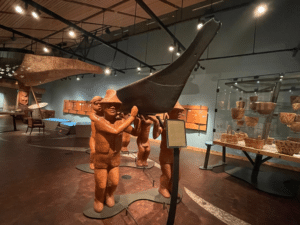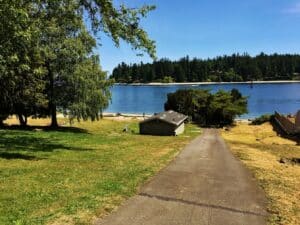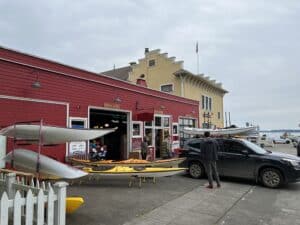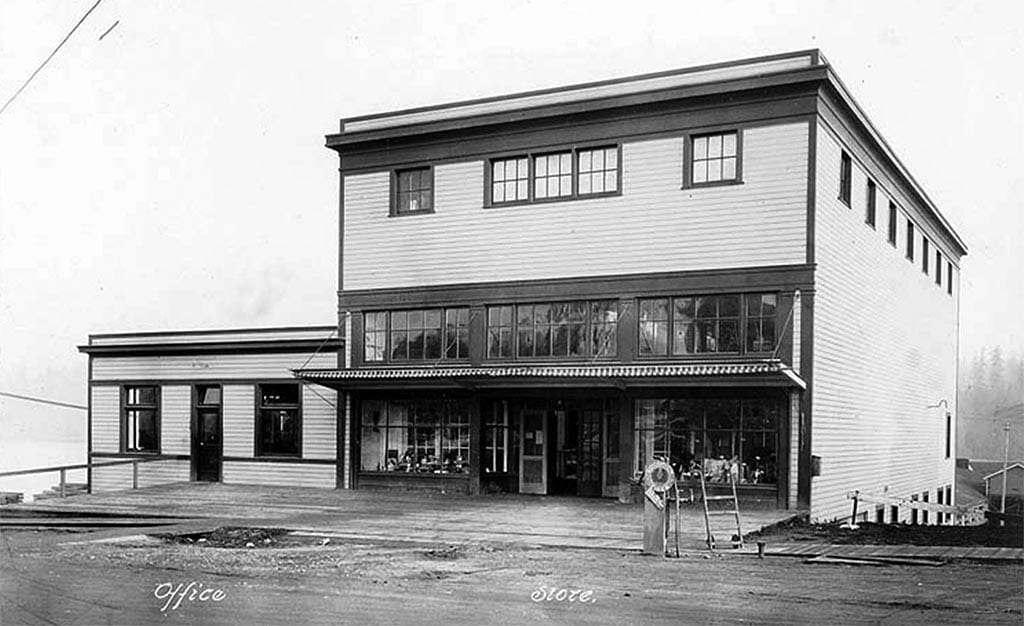For a journey off the beaten path (but not far from home), it’s hard to beat the “Natural Side of Puget Sound”: the Kitsap Peninsula. The northern end of the peninsula is home to charming small towns, dynamic beaches, and world-class museums. Summer visitors can soak in sunny beach days, paddle trips, and outdoor dining, while those traveling in the rainy season will enjoy moody walks along the shore, higher chances of spotting a southern resident killer whale, and some of the best indoor maritime activities the heritage area has to offer. So pack a lunch, hop in the car, and head out for a nearby weekend adventure perfect for any weather.
Getting to North Kitsap
No matter where you’re coming from, it’s impossible to get to the top of the Kitsap Peninsula without some fantastic water views along the way. If you’re coming from the south, you’ll likely drive onto the Kitsap Peninsula by way of the Tacoma Narrows Bridge. From the west, take the Hood Canal Bridge (and watch out for submarines!). For those coming from the east, we highly recommend starting your day on the nation’s largest ferry system. Northern Kitsap Peninsula can be accessed via a Washington State Ferry from Edmonds to Kingston or from Seattle to Bainbridge Island. No reservations are needed for these routes, but we do recommend checking the schedule first and showing up at least 30 minutes early.




Day One
Suquamish Museum and Chief Sealth gravesite
Museum: Open Wednesday-Sunday, 10:00 am-5:00 pm | 6861 NE South St, Suquamish, WA 98392
Gravesite: Open at all times | 7076 NE South St, Suquamish, WA 98392
The Suquamish Museum provides a fantastic first stop on any exploration of the Kitsap Peninsula. This beautifully curated museum aims to collect, protect, educate, and preserve the history and culture of the Puget Sound Salish Tribes with an emphasis on the Suquamish Tribe. Their use of oral history, photography, artifacts, and audio-visual makes this a great place for visitors of all ages to learn about culture and history from the view of the Suquamish Tribe.
We recommend visiting the Suquamish Museum first for important context before walking the easy quarter-mile to the gravesite of Chief Si’ahl’s (also known as Sealth or Seattle). A legendary Tribal leader, this famous chief is also the City of Seattle’s namesake. Don’t miss the interpretive kiosk at the cemetery entrance.
Old Man House Park
Open dawn to dusk | End of NE McKinstry St, Suquamish, WA 98392
After your visit, take a short walk down Division Street to Agate Pass and Old Man House Park. This one-acre waterfront park has a complicated past. Old Man House Park is named for a huge longhouse where Chief Kitsap, Chief Seattle, and his father, Chief Schweabe, lived along with generations of Suquamish people. The longhouse was destroyed by the U.S. government in 1870, and the land was later taken by the military, who then sold it to private land developers. A small portion of the land was converted to a state park, which was returned to the Suquamish Tribe by Washington State Parks in 2004.

Picnic on the beach at Point No Point Lighthouse Beach
Open dawn to dusk | 9009 Point No Point Rd NE, Hansville, WA 98340 | Parking available at WDFW parking lot nearby
Continue your adventure with a visit to one of the most scenic lighthouses in the state—not to mention a beautiful beach—at Point No Point Park. The Point No Point Lighthouse was built in 1879 and is considered to be the oldest lighthouse in Puget Sound. It’s located in a charming county park on a low, sandy spit that marks the entrance to Puget Sound from Admiralty Inlet.
The spit was the site of the Point No Point Treaty, signed by Washington’s Territorial Governor Isaac I. Stevens and delegates from several Tribes of the Olympic Peninsula, including the Elwha Klallam, Jamestown S’Klallam, Port Gamble S’Klallam, and Skokomish Tribes, among others. Keep an eye out for the sign marking the site of this historic event.
Point No Point Park is a fantastic place to stop for a picnic and relax by the water, with plenty of sandy beaches and tidepools at low tide. It’s also a fantastic place to search for wildlife as both an Internationally Recognized Important Bird Area and an official site on the Whale Trail. Salmon-eating southern resident killer whales are often sighted here in the winter, but transient orcas can be spotted year-round. The best place to spot marine mammals is near the lighthouse at the east end of the point.
An Afternoon in Port Gamble
After relaxing at the beach, it’s just a short 20-minute drive to the mill town of Port Gamble. This 120-acre National Historic Landmark is a remarkably preserved turn-of-the-century mill town built around what was the longest continually operating saw mill in the country at the time of its closure in 1995. Today, it’s a walkable and family-friendly town with plenty of historic charm. Spend an hour or two wandering the streets and greens of Port Gamble, exploring their extensive General Store, grabbing coffee or a glass of wine, and enjoying an early dinner in town.
If time and weather permit, we also highly recommend getting onto the water! Olympic Outdoor Center (32379 N Rainier Ave., Port Gamble, WA 98364) offers kayak and paddleboard rentals until 5:00 pm in the winter and 6:00 pm in the summer.






Port Gamble Historic Museum
Open May 2-October 6, 2024, Thursday-Sunday, 12:00 pm-5:00 pm | 32400 N Rainier Ave, Port Gamble, WA 98364
For those visiting in the warmer months, don’t miss your chance to visit the fantastic Port Gamble Historic Museum, chock full of history from one of the state’s oldest towns. Located in the historic 1916 mill site offices, the museum includes an impressive collection of artifacts related to the historic sawmill and a peek into the relationship between the lumber and maritime industries in Washington.
Pro tip: If you’re a fan of the paranormal, we recommend asking the docent for their best Port Gamble ghost story—there are plenty! For the really dedicated, time your visit to coincide with Port Gamble’s Annual Ghost Conference, usually held in the fall.

“I would recommend viewing the ‘Captain’s exhibit’ showcasing Capt. William Talbot’s quarters. The post/beam in the exhibit is actually from one of his ships! You also don’t want to miss the land grant to Port Gamble signed December 1864 by Abraham Lincoln.”
Overnight
After a busy first day, you have plenty of options for fun, scenic, and historic places to rest your head around the North Kitsap Peninsula:
- If you’re looking for some of the most unique accommodations in Washington State, head back to Point No Point to spend the night in the lightstation! The United States Lighthouse Society rents out both the Keeper’s Quarters and an adjacent small cottage. Visit their website for more information about how to book your stay.
- Kitsap Memorial State Park also offers year-round accommodations in four charming cabins available for rent. For those visiting in the summer, we’re also a big fan of their campsites, all of which are located close to the peaceful waters of Hood Canal and offer plenty of access for boating.
- Port Gamble has several historic waterfront guest houses available for rent.
- If you’d like to get a head start on Day Two, make the short drive down to Poulsbo, where you’ll find plenty of accommodation options.

Day Two
Poulsbo Maritime Museum
Open daily, 10:00 am-4:00 pm | 19010 Front St NE, Poulsbo, WA 98370
Start the second day of your North Kitsap adventure with a trip to the Poulsbo Maritime Museum. With an impressive collection and plenty of hands-on opportunities—including bells, pulleys, and a real-life foghorn!—this museum is perfect for kids of all ages to learn about the fishing industry, water sports, boatbuilding, and transportation. Don’t miss the outdoor portion of their collection, which includes a replica wheelhouse of the Hyak, the wooden-hulled steamship that connected the Northern Kitsap Peninsula to Seattle as part of the famous “Mosquito Fleet.”

“I love it when families with children drop in. Sure, the kids’ eyes light up when they see the toys in the gift shop. But I like to get the older children’s attention, walk them to the museum entrance, and tell them how time was called out aboard the Pacific Coast Codfish Company schooners. I teach them how the four-hour shift was divided into eight half-hour segments, demonstrate how to work the ship’s bell, and give them an hour and ask them to ring out the time. They love it. I move on down the hall and tell them how these old schooners—in the absence of electricity or steam—could warn other ships when it was foggy. I then instruct them on how to sound off the foghorn.”
Lunch in Downtown Poulsbo
The City of Poulsbo’s Scandinavian heritage has earned it the affectionate nickname of “Little Norway.” Stroll the galleries and shops of Front Street and make a stop at Liberty Bay Waterfront Park before grabbing lunch at one of several waterfront restaurants.






U.S. Naval Undersea Museum
Open Wednesday-Monday, 10:00 am-4:00 pm | 1 Garnett Way, Keyport, WA 98345
After lunch, make the short 15-minute drive south to the U.S. Naval Undersea Museum—one of the most unique museums in the heritage area. Admission is free to this impressive museum focused on the Navy’s undersea operations, technology, combat research, and salvage. From mines and torpedos to submarine rescues and Navy dolphins, this fascinating museum has something for everyone.

“A favorite experience for families with children is the Greenling control room. It’s also one of my favorites! Children can sit in the same seats that the sailors sit in to drive the submarine. We also have a periscope, which the children can use to find their car in the parking lot. [I also] really enjoy our ‘Marine Mammals: The Navy’s Super Searchers’ exhibit. This is where the family can learn about how the Navy uses highly-trained dolphins and sea lions to carry out missions all over the world. There are videos on how the Navy trains and takes care of the mammals.”

















